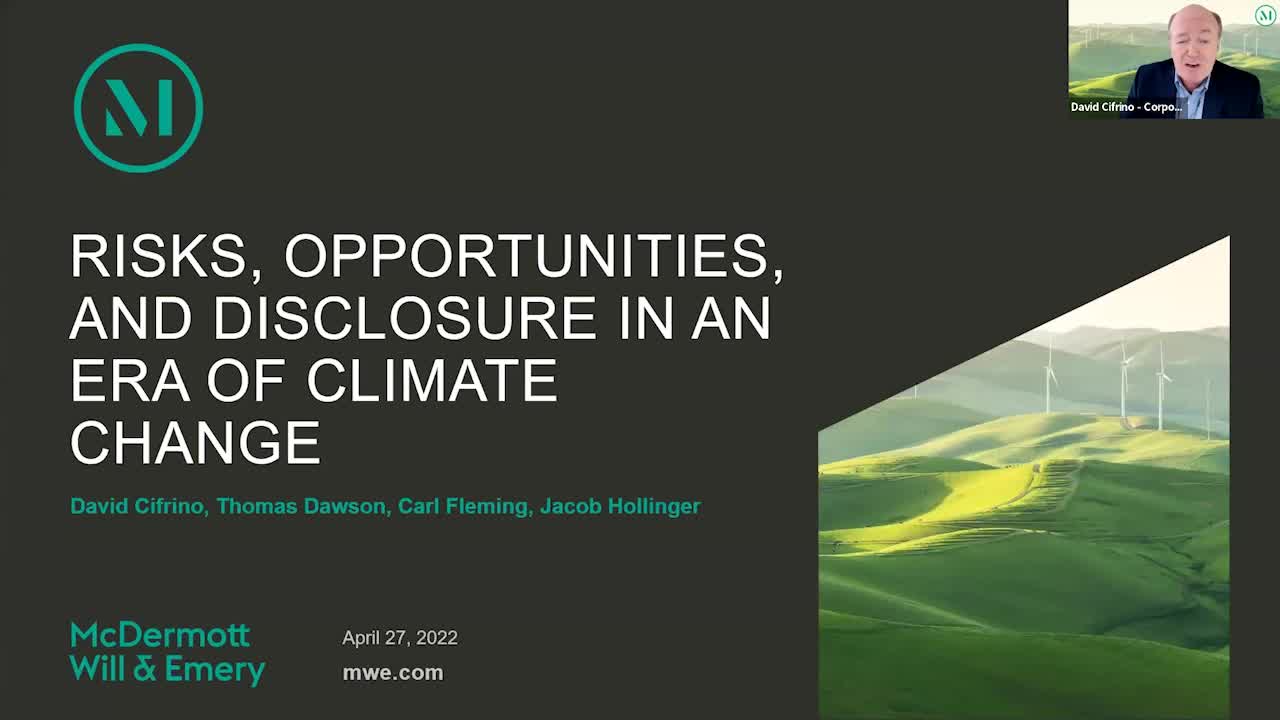Overview

On April 27, members from McDermott’s ESG, Impact & Sustainability Group, including Counsel David Cifrino and Partners Thomas Dawson, Carl Fleming and Jacob Hollinger, hosted a webinar on risks, opportunities and disclosures in an era of climate change.
Below are key takeaways from the webinar:
- There is intense industry and investor interest in new rules the United States Securities and Exchange Commission (SEC) has proposed on climate-related risk disclosure and how they harmonize with international sustainability standards. The proposed disclosure is very specific and detailed and would apply to companies in all sectors. The disclosure can be divided into three separate categories: a separate non-financial “Climate-Related Disclosure” section in annual reports and registration statements on climate-related governance, risk management, strategy, and goals; detailed reporting of greenhouse gas emissions, and financial statement climate-related metrics.
- The SEC proposal for greenhouse gas reporting has many differences from the Environmental Protection Agency’s (EPA) existing Greenhouse Gas Reporting Rule, although the two sets of requirements are not necessarily inconsistent. Some aspects of the SEC proposal that are not in the EPA rules include: required reporting from the SEC registrant rather than being facility or supplier specific; no reporting threshold; contains no set mandatory calculation methodology; and has a third-party attestation requirement.
- US insurers face separate specific considerations with respect to the rules. Of the approximately 5,000 insurers in the US, only about 110 are SEC registrants. States are typically the primary regulators for insurers and some states have existing annual climate disclosure requirements. Currently 35 states do not have such requirements, but it remains to be seen whether the SEC proposal will push more states to require submission of annual climate disclosures or to modify other disclosure filing requirements to include specific climate risk disclosure items.
- The main “megatrend” in the market is toward decarbonization which impacts valuations, operations, employees and markets. Renewable energy is expected to continue its record growth through 2050. Several factors driving this growth includes technology improvements, decreasing costs, improved battery storage and a supportive policy environment.
- Independent power producers are potential partners in helping Fortune 100 companies, tech giants and governments “go green.” For entities that cannot produce green energy but want to ensure their energy comes from green sources, corporate power purchase agreements with independent power producers provide a way of doing so.
- Corporations bought a record 31.1 gigawatts of clean energy through power purchase agreements, or PPAs, in 2021. This is up nearly 24% from the previous year’s record of 25.1GW.
Read more on “SEC Proposes Landmark Standardized Disclosure Rules on Climate-Related Risks” and “Climate Change Regulatory Update for US Insurers”.